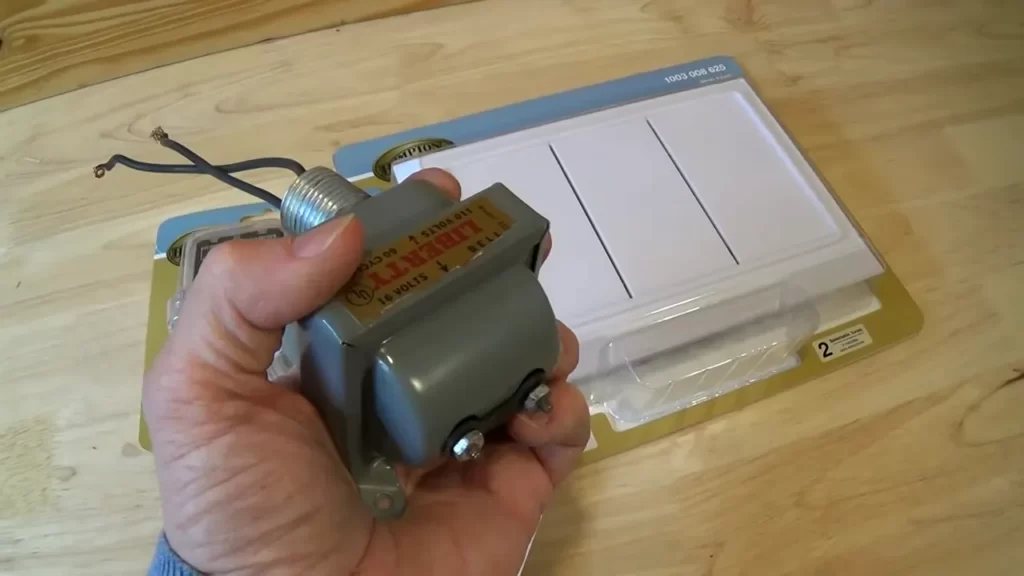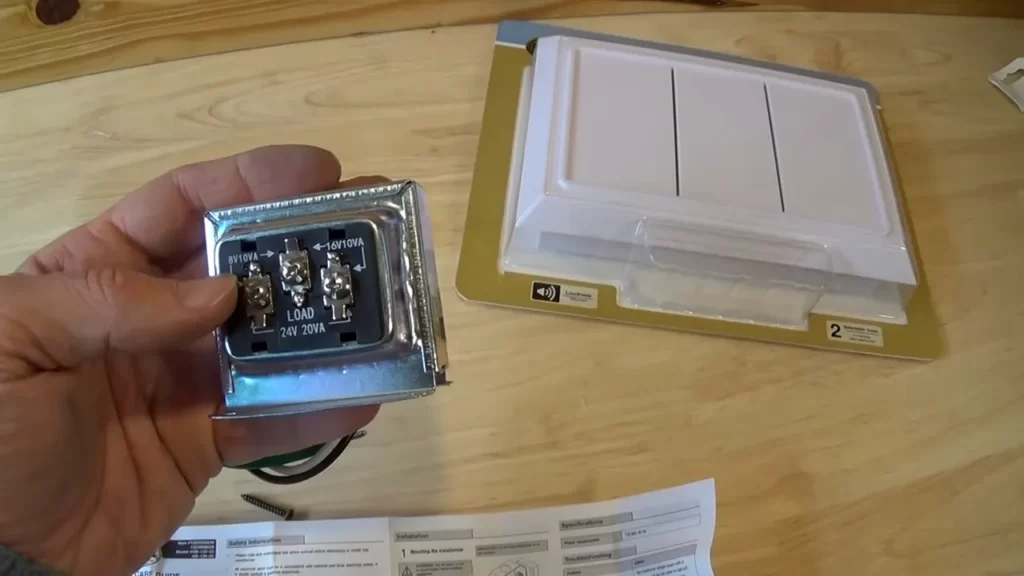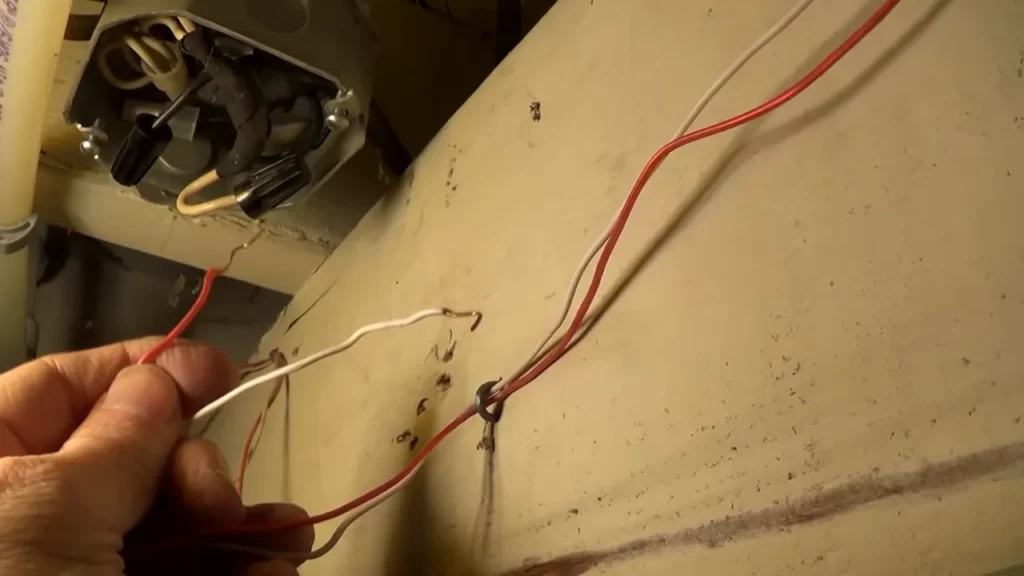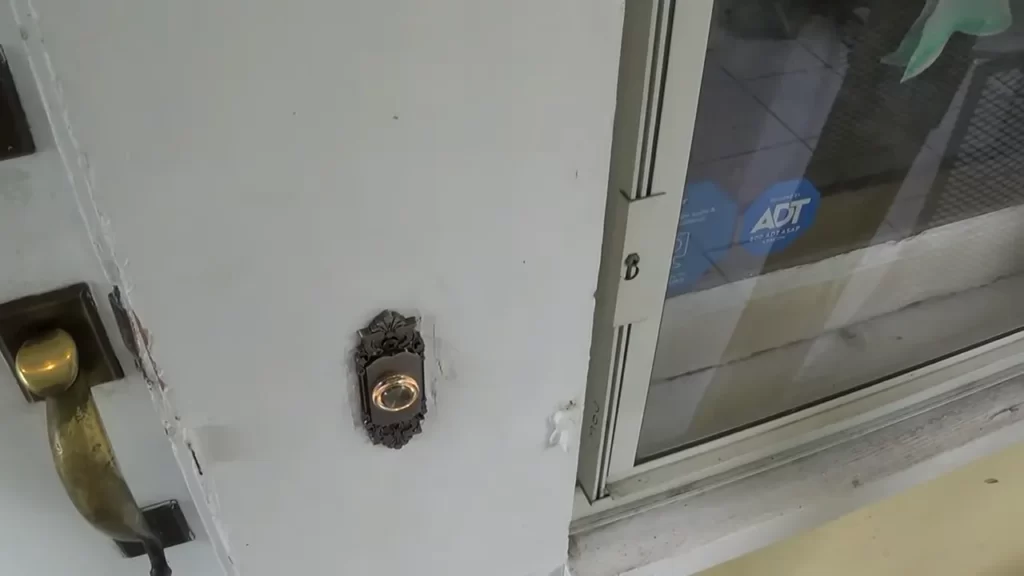To install a doorbell chime, first, disconnect the power to the old chime, remove it from the wall, and disconnect the wires. Then, connect the wires to the new chime, mount it on the wall, and connect it to the power supply.
Welcome to our guide on installing a doorbell chime. Doorbell chimes are an essential part of any home, allowing you to hear when someone is at your door. Whether you are replacing an old chime or installing a new one, the process can be quite simple if you follow the correct steps.
In this guide, we will provide you with clear instructions on how to install a doorbell chime, ensuring that your doorbell system is fully functional and reliable. So let’s get started and transform the way you receive visitors at your door.
Choosing The Right Doorbell Chime

When it comes to choosing a doorbell chime, it’s important to select the right one that suits both your personal style and the functionality you desire. With the wide variety of doorbell chimes available on the market, it can be overwhelming to make a decision. However, by considering a few key factors and understanding the different options available, you can easily find a doorbell chime that perfectly complements your home and meets your needs.
Factors to consider when selecting a doorbell chime
Before diving into the decision-making process, there are several important factors to consider when selecting a doorbell chime. These factors will help guide your search and ensure that you choose a chime that is right for you:
- Compatibility: The first consideration is whether the doorbell chime you are interested in is compatible with your existing doorbell system. Some chimes are designed specifically for wired systems, while others are wireless and can work with a variety of systems.
- Style: Another important factor is the style of the doorbell chime. It should match the aesthetic of your home’s interior and exterior. Whether you prefer a traditional, contemporary, or vintage look, there is a doorbell chime out there that will fit your desired style.
- Sound: The sound of the doorbell chime is of utmost importance. You want a chime that is loud enough to be heard throughout your home but not too jarring or unpleasant. Consider the volume and tone options provided by different chimes to find the one that suits your preferences.
- Installation: The ease of installation is another factor to consider. Some doorbell chimes require professional installation, while others can be easily installed by homeowners with basic DIY skills. Take a look at the installation process and determine whether you will need outside assistance or not.
Understanding the different types of doorbell chimes available
Now that you have a good understanding of the factors to consider, let’s take a look at some of the different types of doorbell chimes available:
| Type of Doorbell Chime | Description |
|---|---|
| Wired Doorbell Chimes | These chimes are connected directly to your home’s electrical system. They require wiring and professional installation, but typically offer a wide range of sound options and compatibility. |
| Wireless Doorbell Chimes | These chimes are battery-powered and do not require any wiring. They can be easily installed by homeowners and offer flexibility in terms of placement. |
| Smart Doorbell Chimes | These chimes are compatible with smart home systems and can be controlled through a smartphone app. They often come with additional features like video monitoring and motion detection. |
Popular features to look for in a doorbell chime
In addition to the type of doorbell chime, there are several popular features you may want to look for when making your selection:
- Volume control: This feature allows you to adjust the sound level of the chime, ensuring it’s not too loud or too quiet.
- Tone options: Having different tone options allows you to customize the sound of the chime to your liking.
- LED lights: Some doorbell chimes come with LED lights that provide visual notifications in addition to sound.
- Compatibility with existing smart home systems: If you already have a smart home system in place, you may want to choose a chime that is compatible with it for seamless integration.
By considering these factors and understanding the different types of chimes available, you will be well-equipped to choose the perfect doorbell chime for your home. Remember to prioritize your personal preferences and requirements to ensure a seamless and enjoyable experience with your new doorbell chime.
Gathering The Required Tools And Materials

Before starting the installation process of your doorbell chime, it is important to gather all the necessary tools and materials. This will ensure a smooth and efficient installation without any interruptions. In this section, we will discuss the essential tools needed, the materials required, and some optional tools and materials that can enhance the installation process.
Essential tools needed for the installation process
To install a doorbell chime, you will need the following tools:
- Screwdriver – A flathead or Phillips screwdriver will be required to open up the chime cover and connect the wires.
- Wire strippers – These will be useful for stripping the insulation off the wires for proper connections.
- Wire cutters – Use wire cutters to trim and shape the wires as needed.
- Electrical tape – Use electrical tape to secure the wire connections and prevent any accidental shorts.
- Drill and drill bits – If necessary, a drill and appropriate drill bits will be needed for mounting the chime to the wall.
Materials required for a successful doorbell chime installation
In addition to the tools mentioned above, you will need the following materials:
- Doorbell chime – Choose a quality doorbell chime that suits your preferences and matches your home’s decor.
- Doorbell transformer – Ensure you have a compatible transformer that supplies the appropriate voltage to the chime.
- Mounting screws – These will be required to securely fasten the doorbell chime to the wall.
- Wire connectors – Use wire connectors to join the wires from the chime to the transformer and doorbell button.
- Drywall anchors – If you are installing the chime onto drywall, use drywall anchors to provide extra support.
Optional tools and materials to enhance the installation process
While not necessary, the following optional tools and materials can make the installation process easier and more efficient:
- Stud finder – If you are mounting the chime onto a wall stud, a stud finder can help locate the ideal spot for installation.
- Wire labels – It can be helpful to label the wires during installation to ensure correct connections.
- Wireless doorbell extender – If you have a large house or thick walls, a wireless doorbell extender can extend the range of your doorbell signal.
- Cable ties – Use cable ties to neatly organize and secure the wires during installation.
Gathering all the necessary tools and materials beforehand will save you time and prevent any delays during the installation process. It is always better to be prepared and ensure you have everything you need at hand.
Step-By-Step Guide: Installing The Doorbell Chime
Welcome to our step-by-step guide on how to install a doorbell chime! Whether you’re replacing an old chime or installing a brand-new one, this guide will walk you through the process from start to finish. In this section, we will focus on the installation process itself, divided into five easy-to-follow steps. So, let’s get started!
Assessing the existing doorbell system
Before beginning the installation process, it is crucial to assess the existing doorbell system to ensure compatibility and safety. First, locate the current doorbell chime and take note of the type of wiring used. Commonly, doorbell systems use either a two-wire or three-wire setup. Also, determine the voltage of the system, typically either 16 volts or 24 volts. These details will be essential when selecting a new chime and wiring it properly.
Safely turning off the power to the doorbell circuit
To ensure safety during the installation process, it is crucial to turn off the power to the doorbell circuit. Locate the circuit breaker or fuse corresponding to the doorbell system and switch it off. If you are unsure which circuit controls the doorbell, it is advisable to turn off the main power to your home. This step will prevent any accidental shocks or electrical shorts while working on the wiring. Safety should always be a top priority!
Removing the old doorbell chime

Once the power is turned off, you can safely remove the old doorbell chime. Start by removing the chime cover, which is typically held in place with screws. Carefully unscrew and disconnect the wires from the terminals on the old chime, taking note of their respective locations. Once the wires are disconnected, remove the old chime from the mounting location, allowing space for the new chime.
Preparing the mounting location for the new chime
Now that the old chime is removed, it’s time to prepare the mounting location for the new chime. Check if the existing holes align with the new chime’s mounting plate. If not, use a pencil or marker to mark the new hole locations based on the dimensions of the new chime. If necessary, use a drill to create new holes to ensure a secure fit for the new chime. Once the mountings holes are ready, attach the mounting plate using screws or the method recommended by the chime’s manufacturer.
Wiring the new doorbell chime
With the mounting plate securely in place, it’s time to wire the new doorbell chime. Refer to the instructions provided by the manufacturer of the new chime for specific wiring details, as they may vary depending on the model. Generally, connect the wires from the doorbell system to the corresponding terminals on the new chime. Ensure a secure connection by tightening the screws on the terminal block. Double-check that the wires are correctly connected and that there are no loose or exposed connections.
Testing the doorbell chime functionality
Finally, it’s time to test the functionality of the newly installed doorbell chime. Turn the power back on to the doorbell circuit and press the doorbell button to check if the chime rings. If the chime does not ring, double-check the wiring connections and ensure the power is properly restored. If everything is in order, congratulations – you’ve successfully installed your new doorbell chime!
Now that you have successfully installed your doorbell chime, you can enjoy its functionality and add a delightful touch to your home. It’s that simple! If you require further assistance or have any questions, be sure to consult the manufacturer’s instructions or reach out to a professional electrician for guidance. Happy chime installation!
Troubleshooting Common Installation Issues
While installing a doorbell chime can be a straightforward task, sometimes you may encounter issues that require troubleshooting. Identifying and resolving these problems can help ensure a successful installation and optimal functionality. In this section, we will discuss some common installation issues and provide step-by-step solutions to address them.
Identifying and resolving wiring connection problems
One of the most common issues you might encounter during the installation of a doorbell chime is wiring connection problems. These problems can result in the chime not ringing or functioning intermittently. To identify and resolve wiring connection problems, follow these steps:
- Start by checking the wiring connections at both the doorbell button and the chime unit. Ensure that the wires are securely connected to their respective terminals.
- If the wiring connections are loose, gently tighten them using a screwdriver. Make sure not to overtighten, as this could damage the terminals.
- Verify that the wires are properly paired. The most common configuration is two wires, one connected to the “trans” or “front” terminal and the other to the “rear” or “bell” terminal.
- If the connections appear to be correct and the chime still does not work, use a multimeter to test the voltage across the terminals. If there is no voltage, the issue may lie with the transformer or the wiring itself. In such cases, it’s best to consult a professional electrician.
Addressing issues with inadequate chime volume

Another common issue you might encounter with your newly installed doorbell chime is inadequate volume. If the chime is too soft or barely audible, follow these steps to address the problem:
- Check the chime unit’s volume control settings, if applicable. Make sure the volume is set to an appropriate level.
- If there is no volume control or adjusting it doesn’t make a noticeable difference, consider replacing the chime unit with a louder model.
- Ensure that the transformer supplying power to the chime is compatible with its requirements. Insufficient power from the transformer can result in low chime volume. Refer to the manufacturer’s instructions or consult a professional electrician to determine the appropriate transformer power rating.
Dealing with compatibility issues between your doorbell and chime
Compatibility issues between your doorbell button and chime can also arise during installation. If the chime doesn’t respond when the button is pressed, or if the chime only works intermittently, follow these steps to troubleshoot:
- Check the compatibility between the doorbell button and the chime unit. Ensure that they are designed to work together.
- Inspect the doorbell button for any visible damage or corrosion. If necessary, clean or replace the button.
- Verify that the doorbell button wiring is connected securely to the chime unit. Loose or disconnected wires can result in compatibility issues.
- If you are using a wireless doorbell system, make sure that both the button and chime unit are within range and that their batteries are properly inserted.
Troubleshooting doorbell chime malfunctions
In some cases, your doorbell chime may experience malfunctions even after a successful installation. To troubleshoot chime malfunctions, try the following steps:
- Check the power source of the chime unit. Ensure that the transformer is supplying sufficient power.
- Inspect the internal components of the chime unit for any loose connections, damaged wires, or worn-out parts. If you notice any issues, repair or replace the affected components as necessary.
- If the chime unit is wireless, make sure that the batteries are charged and properly inserted. Replace the batteries if necessary.
- Reset the chime unit by turning it off, waiting for a few seconds, and then turning it back on. This can help resolve any temporary glitches or software issues.
By following these troubleshooting steps, you can effectively address common installation issues with your doorbell chime. If you encounter any complex issues or are unsure about the necessary steps, it is always advisable to seek assistance from a professional electrician.
Enhancing The Doorbell Chime Experience
Installing a doorbell chime is a necessity to alert you to visitors, deliveries, and guests at your doorstep. But why settle for a basic doorbell chime when you can enhance your experience and take it to the next level? In this article, we will explore various ways to upgrade, customize, and maintain your doorbell chime to create a comprehensive and personalized system that perfectly fits your needs and preferences.
Upgrading to a wireless doorbell chime system

Gone are the days of tangled wires and limited placement options. Upgrading to a wireless doorbell chime system not only offers convenience but also opens doors to advanced features and customization options.
Wireless doorbell chimes provide the flexibility to place the chime unit anywhere in your home, ensuring you never miss a visitor regardless of which room you are in. Additionally, wireless systems often include multiple chimes that can be placed in different areas of your home, such as the living room, kitchen, or bedroom, to ensure you hear the doorbell from anywhere in the house.
Exploring advanced features and customization options
The modern doorbell chime systems come with a range of advanced features and customization options to suit your preferences.
Some doorbell chimes offer a variety of pre-loaded sound options, allowing you to select the one that best matches your style or the ambiance of your home. Others even allow you to upload your own custom sounds, providing a unique and personal touch to your doorbell experience.
In addition to sound options, many doorbell chimes also offer adjustable volume settings. Whether you prefer a subtle chime or a louder alert, you can easily customize the volume to ensure it’s just right for your home.
Incorporating additional accessories for a comprehensive doorbell system
If you want to take your doorbell chime experience to the next level, consider incorporating additional accessories to create a comprehensive doorbell system.
One popular accessory is a video doorbell, which not only alerts you to visitors but also allows you to see and communicate with them through your smartphone or tablet. This provides an extra layer of security and convenience, giving you peace of mind when you’re away from home.
Another useful accessory is a motion sensor, which can be placed near your front door to detect movement and provide an instant notification when someone approaches. This is especially handy for those times when you may not hear the doorbell chime, ensuring you never miss a visitor.
Maintaining and caring for your doorbell chime
Once you have installed your doorbell chime system, it’s important to maintain and care for it to ensure optimal performance and longevity.
Regularly clean the chime unit and buttons using a soft cloth and mild cleaning solution. This will help keep the chime looking and functioning like new.
Check the batteries in your wireless doorbell chime to ensure they are still providing sufficient power. Replace them as needed to avoid any interruptions in doorbell functionality.
Lastly, make sure all components of your doorbell chime system are securely fastened to prevent any loose connections or malfunctions. This includes ensuring the chime unit is properly mounted and any accessories are aligned correctly.
By following these maintenance tips, you can ensure your doorbell chime continues to provide reliable and effective performance for years to come.
Frequently Asked Questions Of How To Install Doorbell Chime
How Do I Connect My Doorbell To My Chime?
To connect your doorbell to your chime, follow these steps: 1. Locate your chime box and doorbell wiring. 2. Remove the cover from your chime box. 3. Disconnect the existing doorbell wires from the chime terminals. 4. Connect the doorbell wires to the appropriate terminals on the chime.
5. Replace the chime box cover and test your doorbell to ensure it’s working correctly.
How Do You Install A Ring Doorbell Without Existing Wiring?
To install a ring doorbell without existing wiring, you can use a battery-powered option, ensuring easy setup. Simply mount the doorbell, connect it to your Wi-Fi network, and download the app to complete the installation process. No electrical wiring is required.
Where Is The Best Place To Put A Doorbell Chime?
The best place to put a doorbell chime is near the main entrance for convenience and to ensure it can be easily heard.
How Is A Doorbell And Chime Wired?
A doorbell and chime are wired by connecting the wires from the doorbell button to the corresponding terminals on the chime unit. The chime unit is then connected to a power source. Ensure proper insulation and follow manufacturer’s instructions for safe and efficient wiring.
Conclusion
Installing a doorbell chime is a simple process that can greatly improve the functionality and convenience of your home. By following the step-by-step instructions outlined in this blog post, you can easily install a doorbell chime and enjoy the benefits it brings.
From enhancing your home’s security to ensuring that you never miss any visitors, installing a doorbell chime is a worthwhile investment. So don’t wait any longer – get started on installing your doorbell chime and enjoy the convenience it brings to your daily life.
